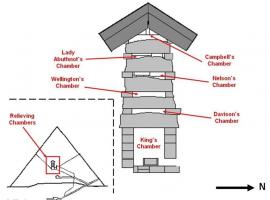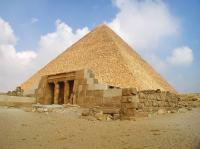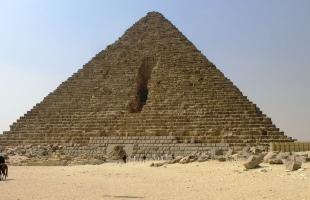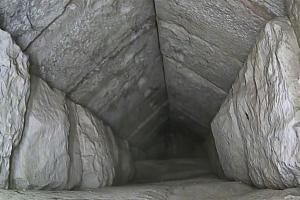Looting Khufu's pyramid: a probable timeline of events
by Anthony Sakovich
Abstract
The entry into Khufu's pyramid has left many questions unanswered. This brief exposition is designed to elucidate the most probable series of events that account for the Arabic records, the physical evidence, and the burial practices we do understand from the Old Kingdom, and put them together in the most logical sequence of events that include and explain all of the factors listed above.
It is quite probable that the main entrance of Khufu's pyramid at Giza was actually known in the time of Caliph Mahmun. Strabo indicates it was known in 20BCE, and we really have no reason to think it would have been lost or forgotten over the years. Since we have no evidence to suggest the location of the entrance was lost, then it is likely that it was used by many people to explore the subterranean passage. In very ancient times, it was through this passage that the contents of the tomb were probably removed, via the long, narrow vertical shaft that leads from the Grand Gallery to the lowest part of the descending passage. This emergency escape tunnel had been left by the builders who released the plugstones... and somebody found it and used it to remove every piece of valuable gold, pottery or statuary they could fit through the passage.
Over time, the long, tortuous vertical shaft became plugged with rocks and debris. Add a few earth tremors, and it becomes completely impassible. In actuality, nobody looking to gain access to the chambers that are high up inside the pyramid would EVER think to use this little hole in the roof of a cave hundreds of feet below the actual burial chambers. In a beautifully camoflauged spot, the tunnel was hidden right out in the open. It simply wasn't worth the effort or risk of clearing it out once it had become plugged.
Now...I ask you to fast forward to 893CE.
While hunting through the descending passage, possibly as a result of his having found the Trial Passages outside for the first time, Caliph Mahmun's men disloged a huge piece of plaster/mortar that was concealing the entrance to the Ascending Passageway. This gave him the location and angle of the passage... but it did NOT tell him what was behind the huge granite plugs. For all he could know, removing the plugs could have brought the entire mountain of stone down on top of them. So, he devised a second plan.
Tunnelling in from outside the pyramid, he knew precisely how far in he had to tunnel through the rock before turning his tunnel left. What he found was a wall of granite plug stones. HE tunneled up the side of the granite plug stones, being very careful not to disturb them, or risk "bringing down the mountain" up on themselves.
When he reached the top of the plug stones, he found that it opened up into the Ascending Passageway, and he was able to climb up and into the Grand Gallery... and eventually even the King's Burial Chamber... only to find it had already been robbed of most significant valuables via the (now plugged) Vertical Shaft. The Vertical shaft, having been plugged with debris from above, was now finally as inaccessible as it had probably been intended to be when it was first constructed in the third millennium BCE.
Still, using his new, larger tunnel, he was able to remove things like the sarcophagus lid, and perhaps even an inner sarcophagus, as well as other grave goods that are attested to in Arabic records, including parts of a mummy.
Naturally, anyone who can find a hole in this timeline is welcome to email me with corrections. No evidence will be ignored.
Email: sakovich@msn.com
(c)2004 Anthony Sakovich, All Rights Reserved


























